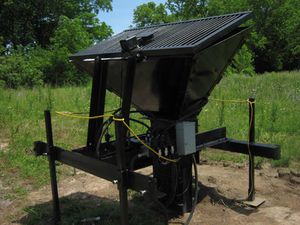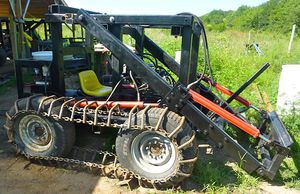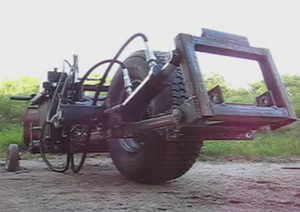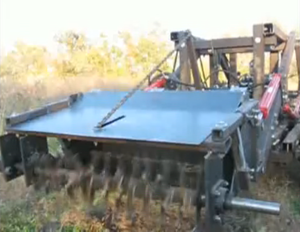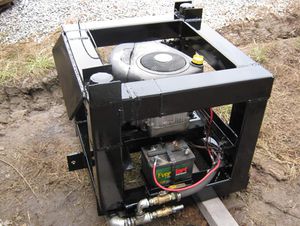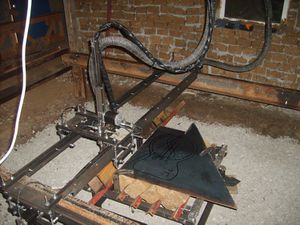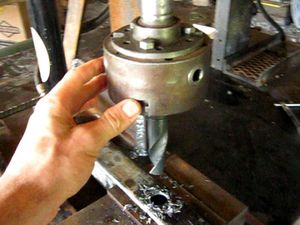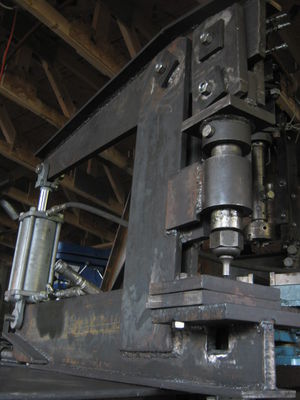Crash course on OSE/pl
| Krótki kurs OSE Oto krótki kurs o Open Source Ecology (OSE). W czasie najbliższych 15 minut dowiesz się wszystkiego o działaniach OSE w ciągu ostatnich 4 lat. Jeśli masz pytania wyślij e-mail na adres crashcoursemoderator (at) gmail.com. Zobacz także Podstawy techniczne GVCS. |
Przegląd
Aby zobaczyć czym się zajmujemy, obejrzyj wideo GVCS w 2 minuty. Open Source Ecology zostało założone w 2004 roku przez Marcina Jakubowskiego. Jesteśmy siecią farmerów, inżynierów i współpracowników, którzy od ponad 3 lat tworzą Globalny Zestaw Narzędzi do Budowy Samowystarczalnej Wioski (GVCS), otwartoźródłową, niskokosztową, wysoko wydajną platformę technologiczną, pozwalającą na łatwe wyprodukowanie we własnym zakresie 50 różnych maszyn przemysłowych, niezbędnych do zbudowania samowystarczalnej cywilizacji o nowoczesnym komforcie.
GVCS obniża bariery przed wejściem w obszar rolnictwa, budownictwa oraz produkcji i może być postrzegane jako zestaw modularnych (na wzór klocków lego) narzędzi, które mogą stworzyć całkowicie nową gospodarkę, zarówno w rolniczych obszarach Missouri, gdzie projekt został założony, jak i na obszarach miejskich czy w sercu Afryki.
Mamy ambitny program ukończenia 49 pozostałych technologii w ciągu 2 lat i budżet wielkości 2,4 miliona dolarów - program ten nazywamy w skrócie programem 50/2/2.
Kluczowe cechy GVCS
Oto Kluczowe cechy GVCS - jeśli chcesz zobaczyć pełny zestaw wartości zobacz Kluczowe wartości OSE.
Kluczowe cechy
|
Zakres GVCS
Zakres
|
Bieżący status
ostatnia aktualizacja: 1 lutego 2012.
Zobacz Przegląd aktualnego stanu (ostatnia aktualizacja 11.05.2012), aby sprawdzić najnowszy rozwój technologii oraz Błyskawiczną EP, aby zobaczyć poszczególne kroki w kwestiach organizacyjnych.
Następujące prototypy i produkty zostały opracowane przed końcem 2011 roku.
| Automatyczna prasa do produkcji cegieł (CEB) pozwala na szybką (16 cegieł na minutę) budowę niskokosztowych, wysokiej jakości konstrukcji z ziemi dostępnej na miejscu. Prasa do cegieł służy do wytłaczania bloków budowlanych z gliniastej ziemi (od 20 do 30% zawartości gliny) pobranej z lokalnej działki.
Stabilizacja przy pomocy cementu może być zastosowana dla większej odporności na pogodę. Prasa może być wykorzystana także do budowy podłóg, chodników, placów, ścian działowych, magazynów i wszelkich innych struktur, w których wykorzystuje się jednolite bloki budowlane. Linki: Liberator, Opowieść o prasie do cegieł, Wstępne testy polowe, wytłaczanie cegieł, pakowanie do przewozu, rama, kontroler, Kompletny opis prasy do cegieł CEB. Dokumentacja: Wprowadzenie, Instrukcje jak skonstruować prasę, Pliki CAD. Prototyp I. Prototyp II.Prototyp III. Prototyp IV | |
| LifeTrac jest uniwersalnym, hydraulicznie napędzanym na 4 koła traktorem o mocy od 18 do 200 KM z opcjonalnymi stalowymi gąsienicami. LifeTrac ma być w założeniu minimalistycznym, ale wysokowydajnym wołem roboczym oraz jednostką napędową, zaprojektowanym by służyć całe życie do wszelkich prac w terenie.
Przystosowany do łatwego demontażu umożliwia naprawę przez użytkownika. Jego modułowa budowa pozwala na szybki montaż i demontaż zespołów roboczych, wymianę i dodawanie hydraulicznych modułów napędowych w celu przystosowania poziomu mocy do aktualnego zadania. Umożliwia szybki montaż/demontaż komponentów hydraulicznych poprzez węże przystosowane do łatwego łączenia, w tym wymianę silników hydraulicznych do użycia w innych zastosowaniach. Linki: Prototyp I; Prototyp I z hydraulicznym modułem napędowym; Rozwijanie Prototypu II, Otwartoźródłowe gąsienice kołowe, Kompletny Prototyp II, w trakcie jazdy. Prototyp III. Prototyp IV. Documentacja: Budowa (strona wiki z instruktażowymi wideo), Pliki Blendera; Pliki CAD modułu jezdnego | |
| MikroTraktor jest pomniejszoną wersją pełnowymiarowego traktora LifeTrac, mającą za zadanie zaspokoić potrzebę na mikrotraktor. Używamy większości tych samych komponentów co w LifeTrac, z wyjątkiem tego, że pomniejszyliśmy wielkość struktury, aby zachować wymienialność części pomiędzy MikroTraktorem a LifeTrac-iem.
Linki: Prototyp I - pełny post na blogu, Wideo na temat ukończonego Prototypu I, 100% zakręt, MikroTraktor - Prototyp II. Dokumentacja: Dokumentacja na wiki ; Prototyp I - plik Blendera | |
| Rozdrabniacz ziemi jest doczepiany do LifeTrac-a i rozbija ziemię na właściwą konsystencję do produkcji cegieł przy użyciu automatycznej prasy do cegieł.
Linki: Prototyp II - wpis na blogu, Budowa i test (krótkie wideo), Test działania (wideo). | |
| The Power Cube is an universal, self-contained power unit that consists of an engine coupled to a hydraulic pump for providing power to different devices in the form of hydraulic fluid at high pressure. The Power Cube is a module that can be attached to the LifeTrac, Microtrac, Bulldozer, and Open Source Car (OSCar) platforms. It connects to other devices via quick couplers and quick-connect hydraulic hoses.
Links: Power_Cube_Prototype_I, Prototype II complete, Prototype II short fab video and Prototype II long fab video. Documentation: Blender Files. | |
| CNC Torch Table is a cutting table. A computer can control the torch head making clean sharp cuts on XYZ axes. Prototype I has been built, but has not been operated successfully because the radiation emitted by the plasma cutter that was used with the table caused electronics failure. We will finish Prototype I by retrofitting it with open source stepper motor controllers.
Links: wiki page, Plasma cutter in action, Open Source Torch Table Part 4, Part 5, Part 6. Documentation: Build (wiki), Blender File; Prototype I First Fire | |
| The Drill Press is for drilling 1″ and larger holes directly in metal without pre-drilling. It contains a hydraulic motor for the drilling and a hydraulic cylinder for the down pressure – so this is a literal press, and it is not short on torque or power as the motor can sustain up to 20 hp. We are using our Universal Rotor for the motor.
Links: video Documentation: documentation | |
| The Ironworker Machine is a device that can instantly cut steel and punch holes in metal thicknesses of 1". Currently the 150 Ton Hole Puncher is prototyped.
Links: 150 Ton Hole Puncher's blog post, Sketchup model Documentation: Hole Puncher's Wiki Documentation, Wiki Category |
In 2011, Marcin gave a TED Talk. We had product orders of the Power Cube, CEB Press, Tractor and Soil Pulverizer and we started with the construction of the HabLab and Workshop. Replications of the GVCS machines started.
We had a successful Kickstarter campaign and received grants from the Kauffman Foundation and Shuttleworth Foundation. Now we are expanding our Resource Development.
We are finishing the Civilization Starter Kit DVD containing full documentation of the Power Cube, CEB Press, Tractor and Soil Pulverizer
We are working now on 13 machines. You can see the current status and needs in the Status Brief.
You can preorder the GVCS machines.
Plany na przyszłość
2012 is rapid parallel development for the completion of the 50 machines. We are scaling our Organizational Development and recruiting a Co-Founder to join the team at Factor e Farm.
First we are planning to open source full beta products in three main groupings:
- The open source Microfactory package - Ironworker machine, CNC Torch Table, CNC Multimachine and Induction Furnace.
- Power Infrastructure Package - Modern Steam Engine, Pelletizer, Solar Concentrator, Heat Exchanger, Power Inverter.
- Construction Package - Well Drilling Rig, Sawmill, Backhoe, Bulldozer.
We are looking for active collaboration in all projects. Our current needs are:
- Fabrication Manager - finish the existing and continue new production runs, produce further construction equipment necessary for infrastructure buildout.
- Construction Project Manager- leading the building new of infrastructure as new people come on site, focusing on natural building techniques such as CEB, local lumber, and local biomass for superinsulation, and bioplastic for greenhouses (see last blog post for details)
- Project Managers – overall global/local project management and integration– utilizing the assistance of a global development team to move forward the creation and testing of the GVCS infrastructure at Factor e Farm
- Machine Designer/CAD – feeds technical design (CAD) into the prototyping process for the GVCS – by providing fabrication drawings to the fabrication team
- OSE Fabricators – custom fabricators and prototypers who convert technical design drawings into physical prototypes – creating the physical substance of the project
- CAM Expert – contributes to the CAM (fabrication automation) aspect of the prototyping process by developing CAM files and by using CNC machines – while streamlining the fabrication process
- Power Engineer – develops the electrical power grid for the community and develops the workshop power supplies – including developing the welder, plasma cutter, induction furnace, inverter, charge controller, and other power electric devices that are included in the GVCS
- Remote Collaboration Support – organizing remote contributor teams for design/CAD/prototyping assistance to Factor e Farm
- CAD/CAM Programmer – A robust, integrated, open source, professional-quality tool chain for CAD/CAM is currently not available. We will put effort into developing such a tool chain to promote the replicability of GVCS tools, by building on and integrating existing tools.
- Land Regeneration Manager – Factor e Farm suffers from serious erosion and fertility issues caused by decades of prior commercial row-cropping. To ameliorate this, our program calls for building berms, ponds, and other earthworks to address erosion directly, plus, extensive mulching, as well as intensive rotational grazing as a rapid way to improve the soil food web. The primary tools that are to be used in these tasks are bulldozers, ruminants, and hay-bales.
- Farmer – or more specifically – the open source agroecologist – the pivotal person in the community who provides nutrition to the FeF team and thereby is the primary contibutor to the good health of the community. The open source agroecologist is responsible for food production – from garden and orchard to field crops, animal husbandry, fishery, and forestry – and for food storage and processing, such as seed cleaning, seed saving, and oil expression. The farmer is responsible for producing food, fuel, and fiber crops (both wood and clothing) – while maintaining a diverse and integrated ecosystem and soil food web that improves in quality over time.
- Cook – feeds the FeF population; engages in crop planning, harvest, and organization of food processing activities
Marcin will give a TED talk on TED Global.
po 2013
After the GVCS completion the first OSE Community will be built and Education and Training in 2-year immersion program are planned.
A Documentary Film about Factory E Farm may come in the future.
Support OSE and collaborate with us to help us make this happen.
Przyłącz się
| Get yourself involved! If you liked what you've seen, please check the Get involved page to see the various ways you can contribute your time and skills to our project |
If you want to join quickly some of the project, then check the Guide to OSE Projects.
Media i wywiady
For Interviews, please check our Press Procedure. Here you can find High Resolution GVCS Media.
Kluczowe słowa
Informacje dla projektantów
- OSE Specifications
- Proposal 2012
- GVCS Development Template
- Product Template
- Development Team
- Wiki Policy
- Forum Policy
Inne
- Preorder the GVCS machines.
- Conferences
- Media Development
Najczęściej zadawane pytania
Do zrobienia
See GVCS Tasks and Project needs.
